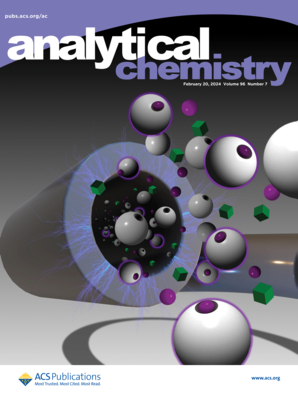具有金属和荧光双重特性的发光金属有机框架探针,用于质控细胞测量和成像
IF 6.7
1区 化学
Q1 CHEMISTRY, ANALYTICAL
引用次数: 0
摘要
质量细胞术(CyTOF)和成像质量细胞术(IMC)作为单细胞分析的前沿技术,能够在单个细胞上同时检测40多种生物标志物。然而,它们的灵敏度和多参数检测能力长期受到金属标记材料发展的限制。同时,IMC作为一种成像技术,其数据采集速度较慢。在这里,我们提出了一种具有荧光和质量双重功能的发光PCN-224-OH材料,并富含Zr-OH - /H2O活性位点。不需要额外的复杂后修饰或化学偶联反应,PCN-224-OH可以直接与抗体/适体和聚乙二醇(PEG)官能化,从而生产PCN-224-Ab-PEG或PCN-224-Apt-PEG探针。我们证明了PCN-224-Ab-PEG与商用聚合物探针兼容,但具有更高的灵敏度和特异性。同时,由于PCN-224-Apt-PEG同时表达荧光信号和质量信号,我们可以采用荧光信号进行快速组织切片扫描,快速识别感兴趣区域(roi),然后在特定roi处采用IMC进行多参数成像。应用PCN-224-Apt-PEG探针可将IMC的盲扫描时间缩短90%,有效补偿IMC的低分辨率。该研究不仅拓宽了发光金属有机框架的应用范围,而且为单细胞多参数检测提供了一个潜在的新工具箱。本文章由计算机程序翻译,如有差异,请以英文原文为准。

Luminescent Metal–Organic Framework Probes with Metallic and Fluorescent Dual-Properties for Mass Cytometry and Imaging
Mass cytometry (CyTOF) and imaging mass cytometry (IMC), as cutting-edge technologies in single-cell analysis, are capable of detecting more than 40 biomarkers simultaneously on a single cell. However, their sensitivity and multiparameter detection capabilities have been long constrained by the development of metal labeling materials. Meanwhile, as an imaging technique, IMC has suffered from a rather slow data acquisition rate. Here, we present a luminescent PCN-224-OH material that exhibits both fluorescent and mass dual-functionality and is enriched with Zr–OH–/H2O active sites. Without the additional need for complex postmodification or chemical coupling reactions, PCN-224-OH can be directly functionalized with antibodies/aptamers and poly(ethylene glycol) (PEG), resulting in the production of PCN-224-Ab-PEG or PCN-224-Apt-PEG probes. We demonstrated that PCN-224-Ab-PEG was compatible with commercial polymer-based probes but with superior sensitivity and specificity. Meanwhile, since PCN-224-Apt-PEG expressed both fluorescence and mass signals, we could adopt fluorescence signals for rapid tissue section scanning to swiftly identify the regions of interest (ROIs), and then adopt IMC for multiparameter imaging at the specific ROIs. The application of the PCN-224-Apt-PEG probe could significantly reduce the blind IMC scanning time by up to 90% and effectively compensate for IMC’s low resolution. This study not only broadens the application scope of luminescent metal–organic frameworks but also offers a potentially novel toolbox for single-cell multiparameter detection.
求助全文
通过发布文献求助,成功后即可免费获取论文全文。
去求助
来源期刊

Analytical Chemistry
化学-分析化学
CiteScore
12.10
自引率
12.20%
发文量
1949
审稿时长
1.4 months
期刊介绍:
Analytical Chemistry, a peer-reviewed research journal, focuses on disseminating new and original knowledge across all branches of analytical chemistry. Fundamental articles may explore general principles of chemical measurement science and need not directly address existing or potential analytical methodology. They can be entirely theoretical or report experimental results. Contributions may cover various phases of analytical operations, including sampling, bioanalysis, electrochemistry, mass spectrometry, microscale and nanoscale systems, environmental analysis, separations, spectroscopy, chemical reactions and selectivity, instrumentation, imaging, surface analysis, and data processing. Papers discussing known analytical methods should present a significant, original application of the method, a notable improvement, or results on an important analyte.
 求助内容:
求助内容: 应助结果提醒方式:
应助结果提醒方式:


